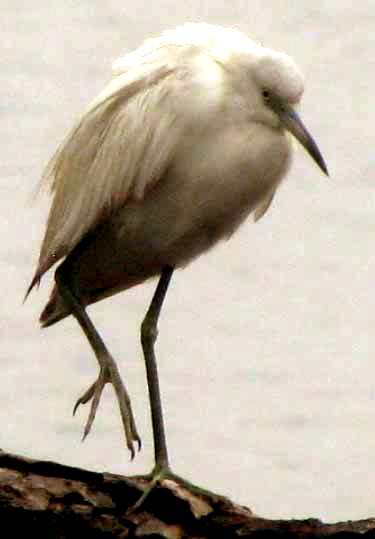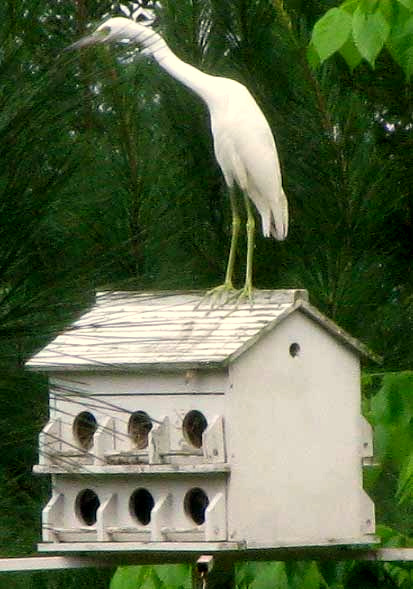Excerpts from Jim Conrad's
Naturalist Newsletter
from the October 23, 2011Newsletter issued from Mayan Beach Garden Inn 20 kms north of Mahahual, Quintana Roo, México
IMMATURE LITTLE BLUE HERON IN THE RAIN
The early part of this week was dark and drizzly with frequent brief showers that moved in off the Caribbean throughout the days. In the mangroves I met an immature Little Blue Heron all scrooched up against the rain and chill, his looks expressing the mood below:

from the August 19, 2012 Newsletter issued from the woods of the Loess Hill Region a few miles east of Natchez, Mississippi, USA
A WHITE, YELLOW-LEGGED, LITTLE BLUE HERON
Now in mid August not only are juvenile birds with strange plumages showing up but also wandering adolescent birds are turning up in strange places. One morning this week I heard a squawking unusual for this wooded area and traced it to big, gawky, white bird perched atop the neighbor's martin box, as shown below:

This is an immature Little Blue Heron, evidently freshly fledged because usually Little Blues in their white juvenile plumage display dark, slate-colored legs, not yellow ones. In the Refuge I saw some blotchy immature Little Blues, so-called Calico Herons, but they were too fast to get a picture of.
from the June 9, 2007 Newsletter issued from Sierra Gorda Biosphere Reserve, QUERÉTARO, MÉXICO
MOLTING LITTLE BLUE HERONS
Though the Howell and Webb guide to Mexican birds -- the "Bible" for serious Mexican birders -- indicates that Little Blue Herons are found in Querétaro only during the winter, we have a couple of birds at the reservoir still with us, and they are something to see. The birds I'm seeing here are in the process of changing from their all-white to their dark plumages, so they have a blotchy look.
The blotchiness isn't random. The birds' outstretched wings are all white, except for a row of emerging dark primary feathers providing the outstretched wings with a well defined dark band extending from wingtip to wingtip. When the birds fly the impression at a distance is that they are white birds ornamented with a large, dark cross across their backs. I'll bet such birds have caused heart palpitations among my pious neighbors, who tend to find religious symbolism wherever they look.
I've seen such blotchy birds referred to as Calico Herons, and some people imagine that they're an entirely different species.
You have to wonder why Nature has gone to such trouble of making immature Little Blue Herons white but adults dark. I think that the consensus is that the immature birds' white plumages enables them to more readily integrate into mixed-species flocks of other white heron species, thus providing an extra measure of protection against predators.
Also, studies show that Snowy Egrets tolerate the close proximity of white Little Blue Herons more than that of dark Little Blue Herons, and that a white Little Blue Heron catches more fish in the company of white Snowy Egrets than when alone.